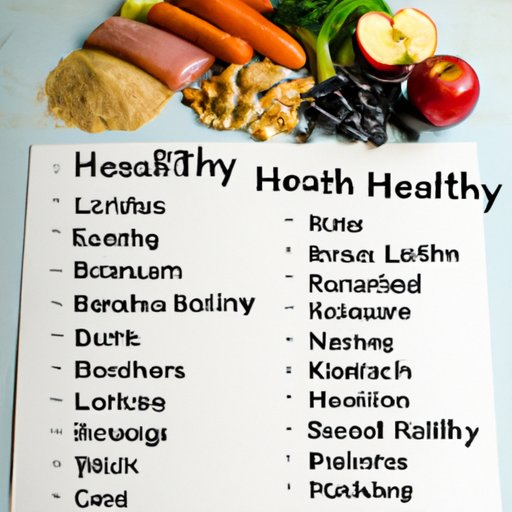Introduction
Eating healthy is the foundation of maintaining a healthy lifestyle. But what does “eating healthy” even mean? It can be difficult to know where to start in creating a nutritious diet that works for you. This article will break down the fundamentals of healthy eating, from understanding macronutrients to exploring superfoods, as well as provide tips for making smart food choices on a budget.

A Guide to Healthy Eating: What to Eat and Why
The first step in understanding what makes up a healthy diet is learning to identify nutrient-rich foods. Nutrient-rich foods are those that contain essential vitamins, minerals, and other nutrients that support physical and mental health. Generally, these foods come from plant sources, such as fruits and vegetables, though some animal proteins can also be nutrient-dense.
It is also important to understand the three macronutrients: carbohydrates, proteins, and fats. Each macronutrient plays a different role in your body – carbohydrates provide energy, proteins help build and repair tissue, and fats aid in cell growth and hormone production. Eating a variety of macronutrients is essential for a balanced diet. Additionally, certain micronutrients, such as vitamins and minerals, are also necessary for optimal health.
Superfoods are nutrient-rich foods that have high levels of antioxidants, phytochemicals, and other beneficial compounds. Some examples of superfoods include blueberries, salmon, kale, quinoa, and chia seeds. While there is no official definition of a superfood, they are generally considered to be highly nutritious and have numerous health benefits.

Creating a Balanced Diet: Understanding the Nutritional Needs of Your Body
Once you understand the basics of nutrition, it is time to create a balanced diet. The first step is to calculate your calorie needs based on your age, gender, activity level, and goals. Once you know your calorie needs, you can determine the ratio of macronutrients you should be eating. Generally, it is recommended that 45-65% of your calories come from carbohydrates, 10-35% from proteins, and 20-35% from fats. Depending on your goals, you may need to adjust your ratios accordingly.
Exploring Superfoods: Incorporating Nutrient-Rich Foods into Your Diet
Incorporating superfoods into your diet can be an easy way to get more nutrients into your meals. Superfoods can be divided into four categories: fruits and vegetables, grains, proteins, and fats and oils. Fruits and vegetables are packed with vitamins, minerals, and antioxidants, while grains provide complex carbohydrates, fiber, and B vitamins. Protein-rich superfoods, such as eggs, fish, and nuts, provide essential amino acids and healthy fats, while fats and oils, such as olive oil and avocados, are rich in monounsaturated fatty acids and antioxidants.
There are many ways to incorporate superfoods into your diet. For example, adding fresh or frozen berries to your morning smoothie or yogurt, swapping out white rice for quinoa, or adding salmon to your dinner plate. You can also try incorporating superfoods into snacks, like snacking on apples with peanut butter or snacking on almonds and dark chocolate chips.

Making Healthy Food Choices on a Budget
Making healthy food choices on a budget can be challenging. There are a few strategies that can help you save money while still eating nutritious meals. First, shop around for the best prices. Compare prices at different stores and look for sales and discounts. Additionally, take advantage of coupons and discounts when available. Bulk buying can also be a great way to save money – buy in bulk and freeze items for later use.
When grocery shopping, focus on buying whole, unprocessed foods. These tend to be cheaper than processed foods and are often more nutritious. Avoid buying pre-packaged convenience foods, which are often more expensive and less healthy. Aim to buy seasonal produce, as it tends to be fresher and cheaper than out of season produce.
Eating for Optimal Health: How to Eat for Maximum Wellness
Optimal health requires more than just a nutrient-rich diet. In addition to eating healthy, staying hydrated, practicing mindful eating, and managing stress levels are all important factors in achieving maximum wellness. Staying hydrated helps to keep your body functioning properly and can help reduce fatigue, headaches, and other symptoms of dehydration. Practicing mindful eating means paying attention to your body’s hunger cues and eating in response to them. Finally, managing stress levels is key for optimal health, as chronic stress can lead to physical and mental health issues over time.
Conclusion
Eating healthy is an important part of maintaining a healthy lifestyle. Understanding the basics of nutrition, such as macronutrients and superfoods, can help you create a balanced diet that meets your individual needs. Additionally, there are many strategies for making healthy food choices on a budget, such as shopping around for the best prices and taking advantage of coupons and discounts. Finally, staying hydrated, practicing mindful eating, and managing stress levels are also important for achieving optimal health.
(Note: Is this article not meeting your expectations? Do you have knowledge or insights to share? Unlock new opportunities and expand your reach by joining our authors team. Click Registration to join us and share your expertise with our readers.)
